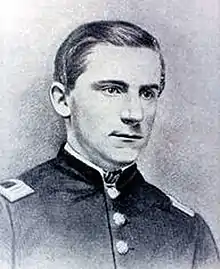George E. Davis (Medal of Honor)
George Evans Davis (December 26, 1839 – June 28, 1926) was a recipient of the Medal of Honor during the American Civil War.
George Evans Davis | |
|---|---|
 Capt. George E. Davis | |
| Born | December 26, 1839 Dunstable, Massachusetts |
| Died | June 28, 1926 (aged 86) Bennington, Vermont |
| Place of burial | |
| Allegiance | United States Union |
| Service/ | Union Army |
| Years of service | 1861, 1862 - 1865 |
| Rank | |
| Unit | |
| Battles/wars | American Civil War |
| Awards | Medal of Honor |
Early life
Davis was born in Dunstable, Massachusetts, and worked as a clerk in a local store.
Civil War
At the start of the war in April 1861, Davis enlisted in the 1st Vermont Infantry for three months service. After his three-month enlistment expired, he returned to his civilian job.
Following President Lincoln's call for more volunteers in July 1862, Davis re-enlisted as a private in Company D, 10th Vermont Infantry. He was quickly elected to the rank of second lieutenant and promoted to first lieutenant in January 1863.
On July 9, 1864, at the Battle of Monocacy, Davis was in command of a small detachment ordered to guard bridges. Despite repeated attacks by the Confederates, Davis's detachment held.
Davis continued to serve with the 10th Vermont Infantry and was promoted to captain during the Shenandoah Valley Campaign. While in winter quarters in Petersburg, Virginia, his cabin accidentally collapsed. Davis suffered an injury to his leg and was discharged due to disability.
Postbellum life
On May 27, 1892, Davis received the Medal of Honor for his command of the bridge defense at Monocacy. He died at the Vermont Soldiers' Home in Bennington, Vermont, and is buried in Lakeview Cemetery in Burlington, Vermont.
Medal of Honor citation

Rank and organization: First Lieutenant, Company D, 10th Vermont Infantry. Place and date: At Monocacy, Md., 9 July 1864. Entered service at: Burlington, Vt. Birth: Dunstable, Mass. Date of issue: 27 May 1892.
Citation:
While in command of a small force, held the approaches to the 2 bridges against repeated assaults of superior numbers, thereby materially delaying Early's advance on Washington.[1]
See also
References
- "Medal of Honor recipients". United States Army Center of Military History. August 3, 2009. Retrieved January 6, 2010.
 This article incorporates public domain material from websites or documents of the United States Army Center of Military History.
This article incorporates public domain material from websites or documents of the United States Army Center of Military History.
External links
- "Davis biography at Monocacy Battlefield, National Park Service". Retrieved September 29, 2010.
- Vermont in the Civil War